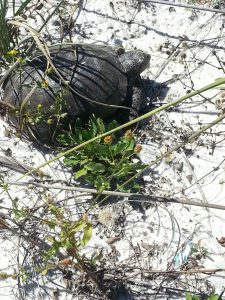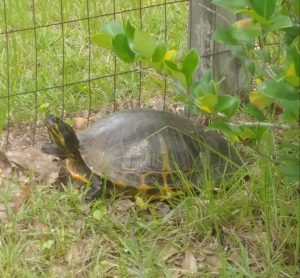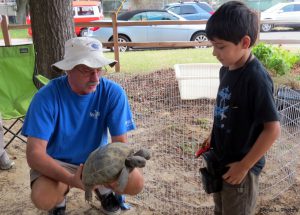How cool, there is nothing wrong with other animals, but how cool for a year to be dedicated to turtles. And how fitting for the Florida panhandle. Based on the publication Biology and Conservation of Florida Turtles (2006), there are 38 taxa of turtles in our state. The majority of these can be found in the panhandle, particularly near the Apalachicola and Escambia Rivers. Within our state some species are only found at these two locations, and some are only found there on the planet.

Photo: DJ Zemenick
Everyone loves turtles.
I hear a lot of stories about families trying to rescue while they are crossing highways. And when it comes to conservation, most will tell you “don’t mess with the turtles”. They are not kola bears… but they’re close. So, we are excited that 2020 is not only the year to Embrace the Gulf of Mexico, but also the Year of Turtle, and we plan to post one article a month highlighting the species richness of our area.
Let’s start with turtles in general.
Most know they are vertebrates but may not know the backbone and ribs support the framework for their famous shell. The top portion of this shell, where the backbone is, is called the carapace. The hard portion covering their chest area is the plastron. And they are connected by the bridge. The shell is a series of bony plates covered with scales (scutes). These scales are what put them in the class Reptilia. Fish also have scales but differ from reptiles in that they have gills instead of lungs. Most turtles are excellent swimmers, but they must hold their breath underwater, and some can do this for quite a long time.

Photo: Deb Mozert
All turtles are in the same Order Chelonia. The terms tortoise and terrapin are more cultural than biological. There are 7 families, and 25 species, of turtles found in Florida. Some are marine, and some terrestrial, but most are what we call “riverine”, living in freshwater.
Turtles lack teeth but do have a blade like beak they can cut with. In general, smooth blades are carnivorous, serrated ones herbivorous, and their omnivorous turtles as well. Most prey are small, and most carnivores must conceal themselves to ambush their prey. Though depicted as slow animals in fairy tales and stories, turtles can be quite fast for a few seconds.
Most are diurnal (active during daylight hours) but some nocturnal activity does occur. They spend parts of their day basking on logs and other platforms to warm – turtles are ectothermic and rely on the sun for heat.

Photo: Molly O’Connor
Mating occurs in the spring. And despite the fact that most are aquatic, nesting occurs on land for all. Except for a few live bearers, reptiles lay cledoic eggs (shelled) buried on dry ground. Sex is determined by the temperature of the egg in all except the softshell turtles, with eggs at 30° C or higher producing females.
Despite their need for warm climates, they can be found throughout the United States. But it is the warm humid southeast where they thrive. Especially the northern Gulf Coast where 60″ of rainfall each year is the norm. We will bring you an article about a new species every other week throughout this year.
Let’s Celebrate the Year if the Turtle.
 0
0
